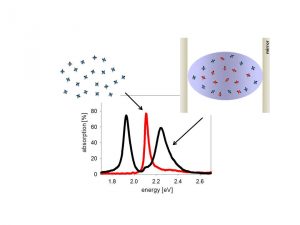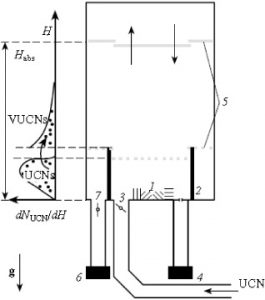CASIMIR-RELATED PHYSICS
PEOPLE
Romain Guérout
Astrid Lambrecht
Serge Reynaud
The theoretical techniques developed for the Casimir effect have applications of interest in various domains. For example, new coupling phenomena come into play at nanometer scales and contribute to the thermal heat transfer which is presently a limiting factor for the use of such devices. Their precise knowledge would allow to comprehend the heat transfer and design new means to control it. This work was performed in collaboration with J.-J. Greffet and J.-P. Hugonin (Institut d’Optique Graduate School, Palaiseau), D.A.R. Dalvit and F.S.S. Rosa (Los Alamos National Laboratory).
Another novel application is investigated using ultracold neutron (UCN) scattering. Experimental results indicate that nanodiamonds or fomblin nanodroplets levitate in the Casimir-Polder potential just above a surface and contribute to the scattering process of the UCN. This may be the explanation of the anomalous heating of ultracold neutrons which has been observed for a long time and is yet unexplained. This study has strong implications for the estimation of the neutron lifetime, one of the important parameters of the standard model. This work was performed in a collaboration with V.V. Nesvizhevsky at Institut Laue-Langevin (ILL, Grenoble), A.Yu. Voronin at Lebedev Institute (Moscow), E.V. Lychagin, A.Yu. Muzychka and A.V. Strelkov at JINR (Dubna).
Light-matter strong coupling has been studied extensively in many different systems. Recently, optical resonances with small mode volumes such as Fabry-Perot nanocavities or surface plasmons have been used to achieve the so-called ultra-strong coupling with organic materials with a Rabi splitting becoming a significant fraction of the electronic transition energy. In a collaboration with C. Genet and T. W. Ebbesen at ISIS (CNRS, University of Strasbourg) we have investigated the changes in bulk properties observed for so large splittings, and explained why unusually long lifetimes are observed for the lowest polariton state.
Strong coupling in organic materials

Molecules coupled to the fundamental optical mode of a 145nm thick cavity. Typical examples of the absorption spectrum of uncoupled (red line) and coupled (dark line) molecules.
Light and matter can be so strongly linked that their characteristics become indistinguishable. These light-matter couplings are referred to as polaritons. Their energy oscillates continuously between both systems, giving rise to attractive new physical phenomena.
In a collaboration with A. Canaguier-Durand, C. Genet and T. W. Ebbesen of ISIS (CNRS, University of Strasbourg) we have explained why such polaritons can remain for an unusual long time at the lowest energy levels, in such a way that alters the microscopic and macroscopic characteristics of their constituting matter.
We have studied polaritons made of organic molecules that are strongly coupled with a small number of photons and examined polariton relaxation dynamics, which occur when polaritons transition from high energy to lower energy levels. To do so, we employed the approach based on “dressed atoms”, which makes it possible to deduce characteristics such as transition rates from high to lower energy levels, for example.
The main output of this study is to explain why the lifetime of the lowest lying polariton energy state is much longer than that of the higher lying state, as revealed initially by experimental results. They differ from those provided by previous theoretical approximation methods, based on the behaviour of uncoupled light and matter, which hold that these states have the same duration.
These findings thus pave the way for optical, electronic and chemical applications. They confirm that it is possible to modify the pathways of vibrational transitions of molecules between higher and lower energy levels, the chemical photoreactions rates, or even to change conductivity in organic semiconductors.
- Non-Markovian polariton dynamics in organic strong coupling, A. Canaguier-Durand, C. Genet, A. Lambrecht, T. W. Ebbesen, S. Reynaud, Eur. Phys. J. D 69 24 (2015)
Quantum levitation of nanoparticles seen with ultracold neutrons

A layout of the gravitational spectrometer of the total UCN energy: (1) the sample, (2) gravitational barrier, (3) entrance valve, (4) monitor detector, (5) UCN absorber, (6) UCN detector and (7) exit valve. A principle scheme of a procedure for measuring small energy transfers is shown in the inset on the left. From bottom to top: an initial UCN spectrum, a dead zone insensitive to VUCN and an energy window of efficient VUCN detection.
Some novel applications of studies on Casimir-Polder forces are investigated in scattering experiments using ultra-cold neutrons, in a collaboration with Valery Nesvizhevsky and his colleagues at Institut Laue-Langevin (ILL) in Grenoble, Lebedev Institute in Moscow and JINR in Dubna.
In the experiments, trapped ultra-cold neutrons (UCN) undergo elastic collisions with nanoparticles moving over the surface of samples placed on the floor of the trap. Collisions increasing neutron energy allows them to overcome gravity and escape the trap. Loss of neutrons due to this process is measured and interpreted in terms of the kinetic properties of nanoparticles. This analysis provides evidence of levitation of nanoparticles at distances above the surface where the Casimir forces have a decisive influence.
This may be the explanation of the anomalous heating of UCN which has been observed for a long time and is yet unexplained.
- Quantum levitation of nanoparticles seen with ultracold neutrons, V.V. Nesvizhevsky, A.Yu. Voronin, A. Lambrecht, S. Reynaud, E.V. Lychagin, A.Yu. Muzychka, A.V. Strelkov, Crystallography Reports 58 743 (2013)
- Temperature dependence of the probability of small heating and total losses of UCNs on the surface of Fomblin oils of different molecular mass, S. M. Cherniavsky, E. V. Lychagin, A. Yu. Muzychka, G. V. Nekhaev, V. V. Nesvizhevsky, S. Reynaud, A. V. Strelkov, K. Turlybekuly Eur. Phys. J. C 79 3293 (2019)
Heat transfer between nanostructured plates
Thermal heat transfer in structured nano-systems is presently the limiting factor for the use of such devices in quantum nano-information. The strong dissipation of energy in these systems is not yet well understood. At the nanometer scale new physical phenomena come into play and contribute to the thermal heat transfer. Their precise knowledge would allow to comprehend the heat transfer and to design means in order to control it. This work was performed in collaboration with J.-J. Greffet and J.-P. Hugonin (Institut d’Optique Graduate School, Palaiseau), D.A.R. Dalvit and F.S.S. Rosa (Los Alamos National Laboratory).

Illustration of the field mode structure (courtesy J.-P. Hugonin, Institut d’Optique Graduate School).
The key point in the understanding of the evanescent modes living on the surfaces. The scattering approach, based on the reflection and transmission matrices of the objects, is particularly well adapted to treat the thermal heat transfer and to take into account the radiation losses. This method takes into account the coupling between surface plasmon resonances (related to the material properties), thermal resonances (due to temperature) and cavity resonances (related to the geometry).
The use of two nano-structured surfaces gives rise to a thermal modulator. The heat transfer is modulated through a lateral displacement of the two corrugated plates with respect to one another. For certain parameters and plate configurations, the heat transfer in near-field can be modulated by more than a factor thirty-five. Calculations based on the Proximity Approximation are shown to give correct estimations when the corrugations are aligned such that two plateaus face each other, but are erroneous when the corrugations are laterally displaced by half the gratings period due to the mode structure (figure on the right column).

Enhancement factor between two gold gratings as a function of the corrugation height, with the distance of closest approach fixed at 1 μm. Blue solid curve (triangles): period d=1 μm. Red solid curve (circles): period d=2.5 μm. Green dashed curve: period d=10 μm. Black dotted curve: proximity approximation.
The far-field radiative heat transfer between good conductive metals is very low at room temperature, since they are very good reflectors at the infrared frequencies of blackbody radiation. The radiative heat transfer is enhanced in the near field, due to the contribution of evanescent surface modes. Polar materials like SiO2 or SiC are in addition favored by the contribution of surface polaritons whose resonance frequencies lie in the infrared. There is an analogous effect for metals arising from the surface plasmons resonances but those lie in the ultraviolet and do not contribute significantly to the heat transfer.
We have shown that it was however possible to considerably enhance the heat transfer by using nano-structured metallic surfaces (figure on the left column). This enhancement is due to the presence of additional modes which appear thanks to the grating structure in the thermal frequency window contributing to the heat transfer.
- Radiative heat transfer between two dielectric nanogratings in the scattering approach, J. Lussange, R. Guérout, F. S. S. Rosa, J.-J. Greffet, A. Lambrecht, S. Reynaud, Phys. Rev. B 86 (2012) 085432
- Enhanced radiative heat transfer between nanostructured gold plates, R. Guérout, J. Lussange, F. S. S. Rosa, J.-P. Hugonin, D.A.R. Dalvit, J.-J. Greffet, A. Lambrecht, S. Reynaud, Phys. Rev. B 85 (2012) 180301(R)
Scattering by a collective dipolar system
We have recently further extended the scope of the scattering method by including the collective phenomena that are involved in many systems interesting for nanophotonics or atomic physics. The theoretical framework can be seen as a combination of the scattering method with the coupled dipoles method often used in nanophotonics. It allows to calculate the scattering matrix by an ensemble of dipoles, taking into account the recurrent diffusion at all
orders, and this without any particular assumption on the lighting or emission conditions.
- Scattering properties of collective dipolar systems, A. Canaguier-Duranda, A. Lambrecht, S. Reynaud, Eur. Phys. J. D 74 (2020) 77
Many applications exist for this formalism, two of them studied in the article demonstrating the power of the new tool. The first concerns the collective absorption properties of an ensemble of coupled dielectric nanospheres behaving like a collective nano-antenna. The second calculates the radiative corrections to energy levels due to interactions in the ensemble. This could allow one to calculate the frequency shifts in “optical clock” systems, that it is crucial to control in a metrological context.
